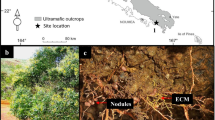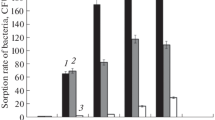Abstract
Soybean (Glycine max L. Merr.) seedlings were inoculated with Glomus mosseae (GM) and Bradyrhizobium japonicum (BJ) together or separately to study the effect of interactions on net H+ effluxes of nodules or extraradical hyphae by in vivo vibrating electrode techniques. GM promoted three-fold the H+ effluxes of nodules on mycorrhizal lateral roots and BJ increased eight-fold the net H+ effluxes of hyphae developing in the vicinity of nodules on lateral roots. Increments in plant P content were positively and linearly correlated with the net H+ efflux of nodules and hyphae. It is concluded that increased H+ effluxes of nodules resulted from enhanced nitrogenase activities induced by the presence of the AM fungus in lateral roots. The results point to additive effects of interactions between mycorrhizal fungi and rhizobia in increasing the extent of acidification of the “nodulesphere” and the hyposphere.






Similar content being viewed by others
References
Akiyama K, Matsuzaki K, Hayashi H (2005) Plant sesquiterpenes induce hyphal branching in arbuscular mycorrhizal fungi. Nature 435:824–827
Allen SE (1989) Chemical analysis of ecological materials. Blackwell, Oxford
Artursson V, Finlay RD, Jansson JK (2006) Interactions between arbuscular mycorrhizal fungi and bacteria and their potential for stimulating plant growth. Environ Microbiol 8:1–10
Asimi S, Gianinazzi-Pearson V, Gianinazzi S (1980) Influence of increasing soil phosphorus levels on interactions between vesicular–arbuscular mycorrhizae and Rhizobium in soybeans. Can J Bot 58:2200–2205
Bell P, Hallmark W, Sabbe W, Dombeck D (1995) Diagnosing nutrient deficiencies in soybean, using M-DRIS and critical nutrient level procedures. Agron J 87:859–865
Bethlenfalvay G, Yoder J (1981) The Glycine–Glomus–Rhizobium symbiosis. Physiol Plant 52:141–145
Bethlenfalvay G, Pacovsky R, Bayne H, Stafford A (1982) Interactions between nitrogen fixation, mycorrhizal colonization, and host-plant growth in the Phaseolus–Rhizobium–Glomus symbiosis. Plant Physiol 70:446–450
Bethlenfalvay G, Brown M, Stafford A (1985) The Glycine–Glomus–Rhizobium symbiosis: II. Antagonistic effects between mycorrhizal colonization and nodulation. Plant Physiol 79:1054–1058
Bonfante P, Anca IA (2009) Plants, mycorrhizal fungi, and bacteria: a network of interactions. Annu Rev Microbiol 63:363–383
Day D, Poole P, Tyerman S, Rosendahl L (2001) Ammonia and amino acid transport across symbiotic membranes in nitrogen-fixing legume nodules. Cell Mol Life Sci 58:61–71
Frey-Klett P, Garbaye J, Tarkka M (2007) The mycorrhiza helper bacteria revisited. New Phytol 176:22–36
Gamalero E, Berta G, Massa N, Glick BR, Lingua G (2008) Synergistic interactions between the ACC deaminase-producing bacterium Pseudomonas putida UW4 and the AM fungus Gigaspora rosea positively affect cucumber plant growth. FEMS Microbiol Ecol 64:459–467
Hardy R, Holsten R, Jackson E, Burns R (1968) The acetylene–ethylene assay for N2 fixation: laboratory and field evaluation. Plant Physiol 43:1185–1207
He XH, Xu MG, Qiu GY, Zhou JB (2009) Use of 15N stable isotope to quantify nitrogen transfer between mycorrhizal plants. JPE 2:107–118
Hinsinger P, Bengough A, Vetterlein D, Young I (2009) Rhizosphere: biophysics, biogeochemistry and ecological relevance. Plant Soil 321:117–152
Hinsinger P, Gobran G, Gregory P, Wenzel W (2005) Rhizosphere geometry and heterogeneity arising from root-mediated physical and chemical processes. New Phytol 168:293–303
Johansson J, Paul L, Finlay R (2004) Microbial interactions in the mycorrhizosphere and their significance for sustainable agriculture. FEMS Microbiol Ecol 48:1–13
Li L, Li SM, Sun JH, Zhou LL, Bao XG, Zhang HG, Zhang FS (2007) Diversity enhances agricultural productivity via rhizosphere phosphorus facilitation on phosphorus-deficient soils. PNAS 104:11192–11196
Li X, George E, Marschner H (1991) Phosphorus depletion and pH decrease at the root–soil and hyphae–soil interfaces of VA mycorrhizal white clover fertilized with ammonium. New Phytol 119:397–404
Lodwig E, Hosie A, Bourdes A, Findlay K, Allaway D, Karunakaran R, Downie J, Poole P (2003) Amino-acid cycling drives nitrogen fixation in the legume–Rhizobium symbiosis. Nature 422:722–726
Maillet F, Poinsot V, André O, Puech-Pagès V, Haouy A, Gueunier M, Cromer L, Giraudet D, Formey D, Niebel A, Martinez EA, Driguez H, Bécard G, Dénarié J (2011) Fungal lipochitooligosaccharide symbiotic signals in arbuscular mycorrhiza. Nature 469:48–64
Olah B, Briere C, Becard G, Denarie J, Gough C (2005) Nod factors and a diffusible factor from arbuscular mycorrhizal fungi stimulate lateral root formation in Medicago truncatula via the DMI1/DMI2 signalling pathway. Plant J 44:195–207
Ramos AC, Façanha AR, Feijó JA (2008) Proton (H+) flux signature for the presymbiotic development of the arbuscular mycorrhizal fungi. New Phytol 178:177–188
Raven J, Smith F (1976) Nitrogen assimilation and transport in vascular land plants in relation to intracellular pH regulation. New Phytol 76:415–431
Raven J, Franco A, de Jesus E, Jacob-Neto J (1990) H+ extrusion and organic-acid synthesis in N2-fixing symbioses involving vascular plants. New Phytol 114:369–389
SAS Institute Inc (1989) SAS/STAT user’s guide. SAS Institute, Cary
Sas L, Rengel Z, Tang C (2001) Excess cation uptake, and extrusion of protons and organic acid anions by Lupinus albus under phosphorus deficiency. Plant Sci 160:1191–1198
Scheublin T, Ridgway K, Young J, Van Der Heijden M (2004) Nonlegumes, legumes, and root nodules harbor different arbuscular mycorrhizal fungal communities. Appl Environ Microbiol 70:6240–6246
Scheublin T, van der Heijden M (2006) Arbuscular mycorrhizal fungi colonize nonfixing root nodules of several legume species. New Phytol 172:732–738
Shi R (1994) Determination of the total nitrogen in plant materials. In: Shi RH, Bao SD, Qin HY, An ZS (eds) Soil agriculture chemistry analysis method. China Agriculture Press, Beijing, pp 213–216
Steinkellner S, Lendzemo V, Langer I, Schweiger P, Khaosaad T, Toussaint J, Vierheilig H (2007) Flavonoids and strigolactones in root exudates as signals in symbiotic and pathogenic plant–fungus interactions. Molecules 12:1290–1306
Tang C, Hinsinger P, Drevon J, Jaillard B (2001) Phosphorus deficiency impairs early nodule functioning and enhances proton release in roots of Medicago truncatula L. Ann Bot 88:131–138
Trouvelot A, Kough J, Gianinazzi-Pearson V (1986) Mesure du taux de mycorhization VA d’un systeme radiculaire. Recherche de methodes d’estimation ayant une signification funvtionnelle. In: Gianinazzi-Pearson V, Gianinazzi S (eds) Physiological and genetic aspectes of mycorrhizae. INRA Press, Paris, pp 217–221
van der Heijden M, Bakker R, Verwaal J, Scheublin T, Rutten M, van Logtestijn R, Staehelin C (2006) Symbiotic bacteria as a determinant of plant community structure and plant productivity in dune grassland. FEMS Microbiol Ecol 56:178–187
Vance CP (2001) Symbiotic nitrogen fixation and phosphorus acquisition. Plant nutrition in a world of declining renewable resources. Plant Physiol 127:390–397
Yao Q, Li X, Feng G, Christie P (2001) Mobilization of sparingly soluble inorganic phosphates by the external mycelium of an arbuscular mycorrhizal fungus. Plant Soil 230:279–285
Acknowledgments
The study was partly supported by the National Natural Science Foundation of China (the major program of 30890132 and the Science Fund for Creative Research Groups of 30821003), Chinese University Scientific Fund (2009TD15), and National Basic Research Program of China (2007CB109308). We acknowledge the assistance of Professor Alastair Fitter and Zed Rangel during early writing stages. We would also like to thank Professor Vivienne Gianinazzi-Pearson and two anonymous reviewers for their constructive comments and revisions.
Author information
Authors and Affiliations
Corresponding author
Electronic supplementary materials
Below is the link to the electronic supplementary material.
Information S1
Measurement of net H+ efflux using the non-invasive micro-test technique (DOC 16.0 kb)
Information S2
Effects of G. mosseae (GM) and/or B. japonicum (BJ) inoculation on P and N concentration (mg g−1 DW) in shoots, roots, and root nodules of soybeans at 56 days after sowing (DOC 30 kb)
Information S3
Net H+ effluxes (pmol cm−2 s−1) in taproot (a) and lateral roots (b) under different treatments. Values are means ± SE (n = 4). Different letters above the bars indicate significant differences at P = 0.05. Abbreviations: LR lateral roots; LR+ lateral roots with nodules; LR− lateral roots without nodules; GM sole inoculated with G. mosseae; BJ sole inoculation with B. japonicum; GM/BJ dual inoculated with G. mosseae + B. japonicum (DOC 33 kb)
Rights and permissions
About this article
Cite this article
Ding, X., Sui, X., Wang, F. et al. Synergistic interactions between Glomus mosseae and Bradyrhizobium japonicum in enhancing proton release from nodules and hyphae. Mycorrhiza 22, 51–58 (2012). https://doi.org/10.1007/s00572-011-0381-3
Received:
Accepted:
Published:
Issue Date:
DOI: https://doi.org/10.1007/s00572-011-0381-3




